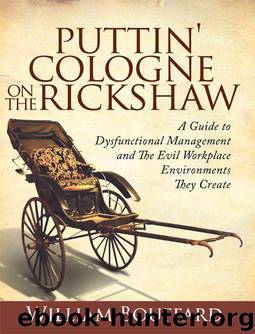Puttin' Cologne on the Rickshaw: A Guide to Dysfunctional Management and the Evil Workplace Environments They Create by William Bouffard

Author:William Bouffard [Bouffard, William]
Language: eng
Format: mobi
Publisher: William\Bouffard
Published: 2012-07-18T14:00:00+00:00
CHAPTER 15 THE RED QUEEN EFFECT
DO YOU EVER FEEL LIKE YOU’RE BEATING your head against the wall or just not getting anywhere at work no matter how hard you try? If so, you probably are the victim of “The Red Queen Effect.”
In 1973, evolutionary biologist, Leigh Van Valen of the University of Chicago, devised what he called the “Red Queen Principle” (also called the “Red Queen Effect”) from Lewis Carroll’s Through the Looking Glass. It’s based on the Red Queen’s comment to Alice that: “in this place it takes all the running you can do to keep in the same place.”
In the workplace, Van Valen’s Red Queen Effect suggests that competing people will have to allocate more and more resources into fighting one another for even a modest, or negligible, increase in benefit.
The Red Queen Effect is a zero sum game that dictates that an improvement in one person’s situation must/will lead to a decrease in another’s. It’s a pretty simple principle actually. If one person develops a competitive advantage that allows that person to capture a larger share of the organizational resources, prestige, or praise from the boss, this will, in turn, lead to a smaller share for other people, thus they suffer a status decrease. The only way that they can survive is by learning how to increase their own status, so that they can regain their share of the resources, prestige or praise. The Red Queen Effect especially plagues sycophants as they jockey for position under the sociopaths.
Take, for example, a rabbit. As it evolves to run faster, it has gained a competitive defensive advantage over its predator, the fox. In turn, the fox then must compensate for its loss of advantage by learning how to run faster. And so on, back and forth. However, the difference between the rabbit and the fox and the average employee is that in the workplace people hardly ever look at themselves as the source of their problems and realize they must change to gain a competitive advantage. It is much easier to just torpedo your competition than change yourself. This game of jockeying for position is played out every day in the workplace.
I’m sure everyone has heard the term “thrown under the bus.” It seems to have entered the business vernacular like gang busters. While quite childish, in a way it serves as the best description of the workplace behavior displayed by people toward one another and provides proof of the Red Queen Effect.
Have you ever heard the old idiom, “If you want the biggest house in the neighborhood you can either roll up your sleeves and build it, or you can tear everyone else’s house down?” This chapter is about how workers tear each other’s houses down.
The urbandictionary.com defines “thrown under the bus” as sacrificing some other person, usually one who is undeserving or at least vulnerable, to make a personal gain. Someone is said to have been thrown under the bus when he or she is made the scapegoat for something that may have gone wrong.
Download
This site does not store any files on its server. We only index and link to content provided by other sites. Please contact the content providers to delete copyright contents if any and email us, we'll remove relevant links or contents immediately.
Tools of Titans by Timothy Ferriss(7814)
Change Your Questions, Change Your Life by Marilee Adams(7376)
Deep Work by Cal Newport(6563)
Man-made Catastrophes and Risk Information Concealment by Dmitry Chernov & Didier Sornette(5649)
Playing to Win_ How Strategy Really Works by A.G. Lafley & Roger L. Martin(5504)
Digital Minimalism by Cal Newport;(5390)
Big Magic: Creative Living Beyond Fear by Elizabeth Gilbert(5352)
The Slight Edge by Jeff Olson(5200)
The Motivation Myth by Jeff Haden(5004)
Ego Is the Enemy by Ryan Holiday(4958)
Stone's Rules by Roger Stone(4857)
The Laws of Human Nature by Robert Greene(4773)
Tuesdays with Morrie by Mitch Albom(4402)
Rising Strong by Brene Brown(4192)
Eat That Frog! by Brian Tracy(4149)
Skin in the Game by Nassim Nicholas Taleb(3967)
The Money Culture by Michael Lewis(3848)
Bullshit Jobs by David Graeber(3831)
Skin in the Game: Hidden Asymmetries in Daily Life by Nassim Nicholas Taleb(3723)
